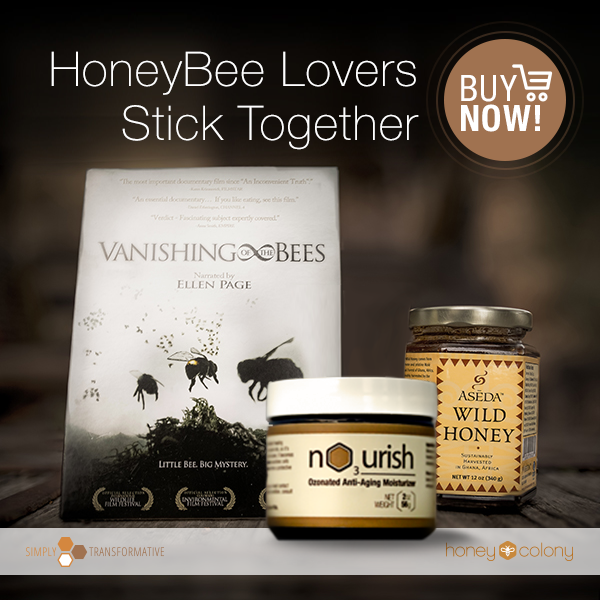According to a new Greenpeace study, Neonicotinoid pesticides pose serious risks not only to honeybees, but also to many other species, including humans.
This year marks a decade since Beekeeper David Hackenberg first alerted the world that honeybees were dying mysteriously. While these past 10 year has observed our consciousness rise around bees, the use of systemic pesticides and their negative impact have also sadly increased. Today, the use of neonicotinoids is slowly killing wild bees, worms, sea life, and other animals, reports Greenpeace. Basically, they endanger the livelihood of our entire planet.
With that said the U.S. Fish and Wildlife Service has placed the patched bumblebee on the endangered species list.
Scientists have found risks with possible ripple effects through the food chain. Based on the new findings, Greenpeace is urging the European Commission to fully ban neonicotinoids (AGAIN) and promote ecological alternatives.
The latest analysis, conducted by scientists at the University of Sussex, reviewed new data from hundreds of studies published since the 2013 adoption of a partial EU ban on the three most popular and dangerous systemic pesticides: clothianidin, imidacloprid, and thiamethoxam.
“The case that neonicotinoids are contributing to wild bee declines and exacerbating honeybee health issues is stronger than it was when the partial EU ban was adopted,” says Dave Goulson, professor of biology and leading European expert on the ecology of bumblebees. Given evidence for such widespread environmental harm it would seem prudent to extend the scope of the current European restriction.
Meanwhile, the Environmental Protection Agency (EPA) just published a much-anticipated series of analyses of risks associated with several bee-toxic neonicotinoid pesticides. The risk assessments include preliminary findings regarding the investigation into the potential harms to pollinators from three chemical insecticides – clothianidin, thiamethoxam, and dinotefuran – along with an update to the imidacloprid pollinator assessment that was published in January 2016.
“Even in their limited scope these risk assessments clearly show harm to bees and other pollinators from uses of neonics. But rather than suspend uses of these harmful chemicals while the agency continues to gather more data, [the] EPA is refusing to take strong regulatory action until late 2018 or 2019,” says Larissa Walker, Center for Food Safety Pollinator Program Director. “Bees and beekeepers have already waited too long for much-needed government protections for pollinators. The time for the EPA to take action is now.”
Center for Food Safety will be thoroughly evaluating the several-hundreds of pages of documents included in the risk assessments and will be responding with regulatory recommendations during the 60-day public comment period.
The NEW DDT
Systemic pesticides have been described as the “new DDT”:
“We are witnessing a threat to the productivity of our natural and farmed environment, equivalent to that posed by organophosphates or DDT,” says Dr. Jean-Marc Bonmatin, the lead author of an analysis of 800 peer-reviewed reports on the risk of neonicotinoids (and the systemic pesticide fipronil). DDT was widely promoted for pest control in the U.S. after World War II, but was subsequently banned due to both environmental and human health concerns.
When I first started producing Vanishing of the Bees, our thesis that systemic pesticides were at the root of these deaths was still disputed. Today, there are hundreds of studies and non-profits working to get these poisons banned. Science clearly shows that neonicotinoids are omnipresent and persistent in the wider environment, not just in agricultural fields. These substances are routinely found in soils, waterways, and wildflowers. The metabolites can be more dangerous than the parent compounds itself and can persist in soil for up to 18 years!
How can manufacturers like Bayer and Syngenta still dispute the evidence? Beekeepers worldwide have concluded the exact damn thing.
According to a Crop Protection Association representative, neonicotinoids are safe. What a farce. And then he used a bit of propaganda that went something like this: “The U.N. Food and Agricultural Organization estimates that to feed a global population set to reach 9.5 billion by 2050 we will need to increase global agricultural productivity by 70 percent.”
The “we-need-to-feed-the-world” propaganda has long been disproved.
The European Union restricted certain uses of clothianidin, imidacloprid, and thiamethoxam in May 2013, based on assessments by the European Food Safety Authority (EFSA), which found that these pesticides are harmful to bees. As part of the decision to introduce a partial ban, the EU required that the producers of the substances submit further information on aspects for which EFSA could not conclude its assessment. On the basis of industry studies, EFSA confirmed in November 2016 that all authorized uses of imidacloprid and clothianidin pose a high risk to bees and that a high risk cannot be excluded. In the case of thiamethoxam, Syngenta has already failed to produce the additional studies needed to back up an EU approval.
Bees are on the brink of extinction and are ancient messengers and environmental indicators alerting us to fundamental changes we need to make in the way we grow food. They are responsible for two out of every three bites of the food we eat. They are paramount to our survival. In the U.S., honeybees contribute over $14 billion to crop production and over a billion jobs depend on pollinators.




